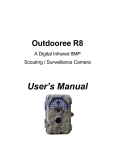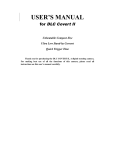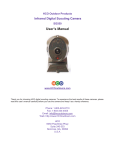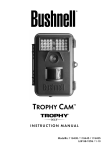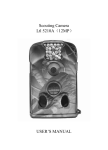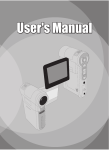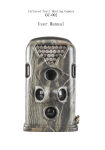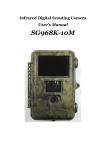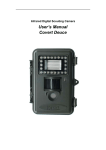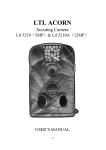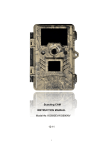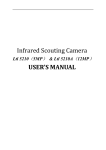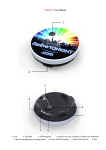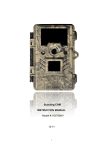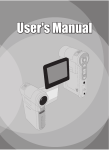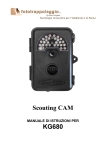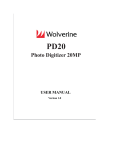Download R5 Came User Manual
Transcript
Outdooree R5 A Digital Infrared 5MP Scouting / Surveillance Camera User’s Manual INDEX 1. Introduction…………………………………………..4 2. Parts and controls ID……………..…………………5 3. Installing Batteries and SD card…………………..7 4. Using and Programming the Outdooree R5…..11 4.1 Set Camera Mode…………………………14 4.2 Restore Factory Default Settings………15 4.3 Set Clock……………………………………16 4.4 Set time stamp……………………………..17 4.5 Set TV Output……………………………...18 4.6 Format SD Card……………………………18 4.7 Set Sensitivity level……………………….19 4.8 Set Interval……………………………........19 4.9 Set Video Length………………………….20 4.10 Set Video Resolution……………………21 4.11 Set Burst Mode/Capture Number.........21 4.12 Set Image Resolution............................22 5. Mounting and Positioning your camera.............22 6. Sensing Angle and Distance test........................23 7. Switching on the camera......................................25 8. Playing back/deleting photos/videos..................25 9. Trouble Shooting/FAQ’s.......................................32 10. Technical Specifications………………………..41 1 2 3 Fig.5 1. Introduction The Outdooree R5 is a digital scouting/surveillance camera which uses a highly sensitive Passive Infra-Red (PIR) motion sensor to detect heat and movement and then take high quality pictures (up to 5MP still photos), or video clips. The Outdooree R5 consumes very little power (less than 300μA) in a standby (surveillance) 4 state. This means it can deliver up to six months stand-by operation time when the device is powered by eight AA alkaline batteries. Once motion in the monitored area is detected, the digital camera unit will be triggered in approximately 1 second and then automatically take photos or videos according to previously programmed settings. The Outdooree R5 is equipped with built-in infrared LEDs for night time illumination, so that it delivers clear photos or videos (in black & white) even in the dark, and it can take color photos or videos under sufficient daylight. The Outdooree R5 is designed for outdoor use and is completely weatherproof. 2. Parts and Controls Identification a. Packing Contents The following items are included with your new Outdooree R5: Keyboard, USB cable, TV cable, and attachment strap. 5 b. Controls The Outdooree R5 provides the following connections for external devices: Keyboard Port, USB port, SD card slot, TV Out, and external DC power in (Fig. 1). Remote Control: Remote Control is a keyboard for setting Outdooree R5’s parameters. The keyboard interface with six keys is primarily used in SETUP mode to select operational functions and parameters. As shown in Fig. 2, these keys are: UP, DOWN, LEFT, RIGHT, OK and MENU. Four of the keys can also perform a second function in addition to their main function: The DOWN key can be used to set the camera to Photo mode (still camera icon), and the UP key can set the camera to Video mode (movie camera icon). The RIGHT key also serves as the manual shutter (SHOT) button of the camera and the OK key switches the camera to the Playback (REPLAY) mode. These secondary functions are indicated by icons or text above the key as shown in Fig. 2. 6 3. INSTALLING THE BATTERIES and SD CARD Before you begin learning how to use your Outdooree R5, you will first need to install a set of batteries and insert an SD card. Although that may only take you a minute, there are some important notes about both batteries and SD cards you should be aware of, so please take the time to read the following directions and cautions: a. Loading Batteries After opening the Outdooree R5 Casing by sliding the bottom cover to the right side, opening the inside cover. You will see the battery compartment. The Outdooree R5 has eight battery slots. Starting from the left of the battery compartment, slots 1, 2, 3 and 4 form one group, while slots 5, 6, 7 and 8 forms the other group, each providing 6 volts in parallel. For maximum battery life, you should install a full set of eight batteries. The Outdooree R5 7 may also be operated by just four batteries installed in the top group only, starting at slot 1. Battery life will be shorter with 4 batteries, but the camera will operate normally. Whether you use 4 or 8, be sure to insert each battery with correct polarity (negative or “flat” end against the long spring of each battery slot). Outdooree recommends using eight new lithium AA or alkaline AA batteries; NiMh Rechargeable batteries can also be used, but they might have a shorter life span due to their reduced efficiency over time and at low temperature. b. Using an External Power Source (optional, user provided) Optionally, you can connect an external 6V DC power source to the “DC In” jack at the bottom of the Outdooree R5. It is recommended to use a power source with a current output greater than 1000mA. However, during bright daytime operation when no flash is required, the Outdooree R5 can function with much less current (>400mA). Please use a compatible 8 power source cable (not provided) to connect the external DC power source with the power input jack of the Outdooree R5, making sure that the polarity is correct. Note: The power connector is a 4.0x1.7mm coaxial DC power plug with positive “tip” (inside pin) polarity (Radio Shack P/N 274-1532 or equivalent). If both an external power source is connected and batteries are installed, the Outdooree R5 will be powered by the external power source. When the batteries become weak, the lowbattery indicator LED will glow blue, indicating the batteries should be changed. c. Inserting the SD Card Warning! Be sure the cameras power switch is turned off before installing batteries or SD card!!!!!!! The Outdooree R5 has 32MB of internal memory, which can hold only about 25 photos (@ 5MP resolution). This is handy for testing and getting familiar with the camera, but you 9 will no doubt want to leave the camera unattended for longer than a day, so using an SD card is recommended. Insert the SD card (with the camera’s power switch in the OFF position) before beginning to operate the camera. Do not insert or remove the SD card when the power switch is in the ON position. The Outdooree R5 uses a standard SD (Secure Digital) memory card to save photos (in .jpg format) and videos. SD and SDHC (High Capacity) cards up to a maximum 16GB capacity are supported. Outdooree recommends using Outdooree or Sandisk brand SD cards. Before inserting the SD card into the card slot after opening the camera’s front cover, please make sure that the writeprotect switch on the card is in the up/off position (when looking at the front of the card the switch is on the left side of the card) (fig. 4). The following describes how to insert and remove the SD card: • Insert the SD card into the card slot with its label side upwards (see above). A “click” sound indicates that the card is installed successfully. If 10 the wrong side of the card is facing up, you will not be able to insert it without force-there is only one correct way to insert cards. Formatting the SD card by using the Outdooree R5 “Format” parameter before using it for the first time is recommended, especially when a card has been used in other devices (see “4.6 Format SD Card” for details). • To take out the SD card, just gently push in the card (do not try to pull it out without pushing in first). The card is released from the slot and ready to be removed when you hear the click. 4. Using and Outdooree R5 Programming the Once you’ve prepared your Outdooree R5 by properly installing batteries and a SD card, you could simply take it outside, strap it to a tree, switch it on and leave. The camera will function in the factory default settings. However, we highly recommend that you first spend some additional time indoors with this manual and your camera until you know a bit 11 more about what the 2-way work state and those Keyboard keys do. If nothing else, you’ll probably want to at least set the date and time so the camera will imprint them on your photos as they are taken, learn how to set the camera to shoot video clips instead of still photos if you like, and read some tips about mounting it on a tree. a. THE OFF, ON, AND SETUP MODES The Outdooree R5 operational modes: has three basic - OFF mode: Power switch in the OFF position. - ON mode: Power switch in the ON position without Keyboard being connected. - SETUP mode: Power switch in the ON position with keyboard being connected. b. OFF mode The OFF mode is the “safe” mode when any actions must be taken, e.g., replacing the SD card or batteries, or transporting the device. 12 You will also use OFF mode if you connect the camera to a computer’s USB port later. c. ON mode Anytime after the batteries and SD card have been inserted, you can switch on the camera. When the power switch is moved to the ON position, the camera will enter into the ON (Live) mode. The motion indicator LED (Fig 3) will blink red for about 10 seconds. This interval allows time for you to close the Outdooree R5’s front cover, lock it, and leave the monitored area. Once in the ON mode, no manual controls are needed or possible. The Outdooree R5 will take photos or videos automatically (according to its current parameter settings) when it is triggered by the PIR sensor’s detection of activity in the area it covers. 13 d. SETUP mode In anytime in the ON mode, the SETUP mode is activated when connecting the keyboard with the Outdooree R5. In OFF mode you just need connect the keyboard with Outdooree R5 and power on the Outdooree R5 if the SETUP mode is needed. Under the SETUP mode you can take over the control of the Outdooree R5 manually or set operational parameters with the help of a display, i.e., the built-in LCD. 4.1 Set Camera mode (video or still images) Enter into SETUP mode first. Two ways for setting this parameter: One is to use the shortcut key and the other is through the MENU. With the shortcut key, set camera mode to “video” by pressing the UP key and set camera mode as “camera” by pressing the DOWN key. With MENU Way, Press the MENU button, Press RIGHT button till “Mode” appears, this 14 parameter has two values: “camera” and “video”. Pressing UP key can switch between these two parameters. Press OK key to save setting or MENU key to cancel setting and exit. Please note, you’ll quit the parameter setting without any saving and no parameter is changed if you press the MENU key at any time before pressing OK key. 4.2 Restore Factory Default settings a. Note: Restoring the factory default settings will remove any previous settings you have saved. b. Enter into SETUP mode, Press the MENU button. c. Press the RIGHT or LEFT key till the “Default” appears, Push the OK key to load default settings or MENU key to cancel this operation. 15 4.3 Set Clock You can set the date and time when necessary, e.g., after every battery change. The format of the date is month/day/year while the time format is hour: minute: second. In MENU state, the steps as following: a. Press the LEFT arrow button until “Set Clock” appears at the top of the screen. b. Press “OK” c. Use “UP” and “DOWN” buttons to change the current hour d. Use “RIGHT” arrow to move highlighted box to minutes e. Use “UP” and “DOWN” buttons to change the current minute f. Use “RIGHT” arrow to move highlighted box to year g. Use “UP” and “DOWN” buttons to change the current year h. Use “RIGHT” arrow to move highlighted box to month i. Use “UP” and “DOWN” buttons to change the current month 16 j. Use “RIGHT” arrow to move highlighted box to day k. Use “UP” and “DOWN” buttons to change the current month l. Press “OK” to save settings After the settings of the date and time, press the OK key to save them or the MENU key to cancel setting. 4.4 Set time stamp This parameter defines whether the time should be stamped in the pictures and video clips or not. a. Press the LEFT arrow button until “Time Stamp” appears at the top of the screen. b. Use “UP” and “DOWN” arrows to choose On or Off. “On” will place the date and time on the lower portion of all pictures and the first frame of videos. c. Press OK key for saving setting or MENU key for canceling operation and exiting. 17 4.5 Set TV output a. Press the LEFT arrow button until “TV Output” appears at the top of the screen. b. In the US, Canada, Mexico, Asia and South America, TV’s are formatted to NTSC, European countries use PAL. Use the “UP” and “DOWN” arrows to select the appropriate TV Output. c. Press “OK” to save setting. 4.6 Format SD card Note: Formatting the SD card will erase all data stored on the card. Do not format if there is important data stored, it will be unrecoverable. Note: Formatting is highly recommended if you are using an SD card that has been used in other electronic equipment such as point and shoot style cameras. a. Press the LEFT arrow button until “Format” appears at the top of the screen. b. Press “OK” c. Use the “UP” and “DOWN” arrows to select “Yes”. 18 d. Press “OK”, a green screen will appear that says “Format Success” and then the screen will return to the format screen. 4.7 Set sensitivity level Note: The sensitivity level dictates how easily the camera triggers. It is recommended to use “Low” sensitivity during winter months to avoid false triggers; “High” for hot summer, “Normal” for spring and fall season. a. Press the LEFT arrow button until “Sensor Level” appears at the top of the screen. b. Use the “UP” and “DOWN” arrows to select “Low”, “Normal” or “High”. c. Press OK key for saving setting or MENU key for canceling operation and exiting. 4.8 Set Interval Note: The interval setting controls how often the camera can trigger, i.e.: a 1 minute 19 interval will cause the camera to only trigger every 1 minute even if there are animals present. This allows the user to eliminate unnecessary pictures. a. Press the MENU button b. Press the LEFT arrow button until “Interval” appears at the top of the screen. c. Use the “UP” and “DOWN” arrows to choose the interval you want. There are interval settings ranging from 1 second to 60 minutes. d. Press OK key for saving setting or MENU key for canceling operation and exiting. 4.9 Set video length a. Press the MENU button. b. Press the LEFT arrow button until “video length” appears at the top of the screen. c. Use the “UP” and “DOWN” arrows to choose the video length you want. There are 56 video length settings ranging from 5 seconds to 60 seconds. d. Press OK key for saving setting or MENU key for canceling operation and exiting. 20 4.10 Set video resolution a. Press the MENU button b. Press the LEFT arrow button until “video size” appears at the top of the screen. c. Use the “UP” and “DOWN” arrows to choose the video size you want. 320x240 is low resolution, 720x480 is high resolution. d. Press OK key to save the current setting or MENU key for canceling setting and exiting. 4.11 Set burst mode/capture number a. Press the MENU button b. Press the LEFT arrow button until “capture number” appears at the top of the screen. c. Use the “UP” and “DOWN” arrows to choose the number of images (1, 2, or 3) you want taken during each activation. 21 d. Press OK key for saving setting or MENU key for canceling operation and exiting. a. b. c. d. 4.12 Set Image resolution Press the MENU button Press the LEFT arrow button until “Image size” appears at the top of the screen. Use the “UP” and “DOWN” arrows to choose the image size you want. 3M is low resolution, 5M is high resolution. Press OK key to save the current setting or MENU key for canceling the setting and quitting. 5. Mounting camera and positioning your After you’ve programmed the camera’s setting to your personal preferences you’re ready to take it outside and slide the power switch to “ON”. When setting up the Outdooree R5 for scouting game or other outdoor applications, you must be sure to mount it in place correctly and 22 securely. We recommend mounting the Outdooree R5 on a sturdy tree with a diameter of about 6-12 inch. To get the optimal picture quality, the tree should be about 10-20 feet away from the place to be monitored, with the camera placed at a height of 2-5 feet. Keep in mind that you will get the best results at night when the subject is within the ideal flash range, no farther than 45’ and no closer than 6’ from the camera. There are two ways to mount the Outdooree R5: using the provided adjustable strap, or the tripod socket. 6. Sensing Angle and Distance Test To test whether the Outdooree R5 can effectively monitor the area you choose, this test is recommended to check the sensing angle and monitoring distance of the Outdooree R5. To perform the test: - Entering into SETUP mode. 23 - Make movements in front of the camera at several positions within the area where you expect the game or subjects to be. Try different distances and angles from the camera. - If the motion indicator LED light blinks, it indicates that position can be sensed. If it does not blink, that position is outside of the sensing area. The results of your testing will help you find the best placement when mounting and aiming the Outdooree R5. The height away from the ground for placing the device should vary with the animal size appropriately. In general, 3 to 5 feet is preferred. You can avoid potential false triggers due to temperature and motion disturbances in front of the camera by not aiming it at a heat source or nearby tree branches or brush (especially on windy days). 24 7. Switching ON the Camera Once you switch to the ON mode, the motion indicator LED (red) (Fig 3) will blink for about 10 seconds. This gives you time to close and lock the front cover of the Outdooree R5 and then walk away. During this time, the motion indicator LED will blink red continuously. After it stops blinking, the PIR is active, and any motion that is detected by it will trigger the capture of photos or videos as programmed in the SETUP Menu. 8. PLAYING BACK/DELETING PHOTOS/VIDEOS the After you have setup, mounted and activated your Outdooree R5, you will of course be eager to return later and review the images it has captured for you. a. Reviewing Images on External Video Monitor 25 an A TV monitor can also be used to play back pictures (or videos) from the device. Connect a TV monitor or a viewing device (such as a digital picture frame) that has a standard composite video input (RCA jack) to the Outdooree R5’s “TV Out” mini jack using the supplied cable. Then: - Entering into SETUP mode. - Press the OK key. The most recently captured image will be shown on the video monitor. For video clips, press the SHOT (RIGHT) key to start playing, press again to stop. - Press the UP key for the previous photo or video and the DOWN key for the next one. When viewing images, the total number of all images in the SD card and the index of the displaying image are shown in the center of LCD and at the bottom of the video monitor respectively. -Press the OK key to return to live preview state (SETUP mode) when playback is finished. 26 b. Deleting Photos or Videos If you see a photo or video during playback on video monitor that you want to delete, it can be done easily without leaving SETUP mode: -Press the MENU key. You will see the first “Delete” screen, which lets you selects the option to delete only the currently displayed photo/video, or all photos/videos (see below). -Highlight the “Delete Current” or “Delete All” option, then press OK. -Next, select “Yes” and press OK to erase only the last displayed photo or video (if you selected “Delete Current”), or every photo and video file on the card (if you selected “Delete All”)-or select “No” and press OK to cancel the operation without deleting any files. NOTE: after deleting a picture or a video file, the deleted files can’t be restored! It is also possible to delete all files from the card by using the Format parameter (See 4.6 Format SD Card) 27 c. Reviewing Images From the SD Card Directly This is the most popular method of viewing images. Since un-mounting the camera and taking it to your computer isn’t very convenient, you may find it easier to just take the card out. By removing the SD card (swapping it for a new empty card if you like) and taking it to your home or campsite to view the images by using an SD card “reader” (user supplied) connected to your computer (some computers and TVs have a built in SD card slot), you can leave the camera in place ready to capture more images. Once connected, the card reader works the same way as described below- please read that section if you have any problem finding your files. d. Reviewing Images by Connecting the Camera to a Computer You can always un-mount the entire camera from the tree and connect its USB port to a 28 computer. It will be recognized as a “removable disk”, without the need to install any drivers or software. When using a PC (or Mac*) to view photos (or video clips*), first connect the device to the computer with the supplied USB cable. Then use commercial software with an image browser feature, or an image browser included with the PC’s operating system to view images saved on the SD card in the folder \DCIM\100EK113. Each new image or video will be numbered incrementally in order of the time it was captured. For example, you will see file names such as “PICT0001.JPG”. Through the file format suffix you can distinguish whether the file is a still photo (with suffix .jpg) or a video. * Video files may require additional software for viewing on a Mac. The Outdooree R5 supports 3 kinds of file system formats, FAT12, FAT16, and FAT32. The default value is FAT16 to save photos and videos. Here are some related notes: 29 • You don’t need to be concerned about the file system format of the Outdooree R5 unless your equipment has problems reading the SD card. If this happens, please format the SD card with the Outdooree R5 or in your computer first and then insert the card into your Outdooree R5 and try again. • The default file system format of the Outdooree R5 is FAT16, which most computers can read. If you format an SD card for the Outdooree R5 in your computer, you should choose the file system format FAT16. Normally FAT16 is recommended unless you have another image viewer that uses FAT12 or FAT32 format. e. DOWNLOADING the PHOTOS and VIDEOS To download your photos/videos to a PC or Mac*, first make sure the Outdooree R5 power switch is in the OFF position. Connect the supplied cable to the camera’s USB port, then directly to a main USB port on your computer30 do not use front panel/keyboard USB ports or unpowered “hubs”. The Outdooree R5 will be recognized as a standard “USB Mass Storage” device (this may take several seconds the first time you connect it). If you would rather leave your camera in the woods and just pull its SD card out, an SD card reader works the same way as described in this section once the card is inserted and the reader is connected to your computer. With Windows XP or later, you can then simply use the options in the pop-up window to copy, view, or print your photos (right). On all Windows OS, the Outdooree R5 will also be listed as a “Removable Disk” if you open the “My Computer” window (on Macs, an icon will appear on your desktop). The Outdooree R5 photo files are named “PICT0001.JPG” etc, and are located in the “DCIM\100EK113” folder on this “Removable Disk”. Video file names will end with “.ASF” or “.AVI”. You may copy the photos/videos to your hard drive as you would any file-just 31 copy/paste or drag the file names or icons to your drive or desktop. After the photos are copied to your hard drive, you can disconnect the Outdooree R5. (On Mac computers, drag the “disk” that appeared on your desktop when the camera was connected into your Trash to “eject” it before disconnecting.) The .jpg standard files from the Outdooree R5 may be viewed and edited with any photo software you choose to use. The video files may be viewed with Windows Media Player (version 7 or later) as well as other video playback programs that may have been supplied with your computer, or are available online. * Video files may require additional software for viewing on a Mac. 9. Trouble shooting/FAQ Battery life is shorter than expected 1. Battery life will vary slightly with operating temperature and the number of images taken 32 over time. Typically, the Outdooree R5 will be able to capture several thousand images before the batteries die. 2. Check to make sure you has used new alkaline or lithium batteries. Outdooree recommends using 8 new alkaline or lithium AA batteries in all Outdooree R5 cameras to obtain maximum battery life. 3. Make sure that the power switch was turned to the ON position and that the camera was not left in SETUP mode while in the field. 4. Make sure that you are using a good quality name brand SD card in your camera. We recommend Outdooree or Sandisk brand SD Cards. Our experience indicates that poor quality SD cards can sometimes reduce your Outdooree R5’s battery life. Camera stops taking images or won’t take images 1. Please make sure that the SD card is not full. If the card is full, the camera will stop taking images. 33 2. Check the batteries to make sure that they are new alkaline or lithium AA batteries. See note above about short battery life. 3. Make sure that the camera power switch is in the ON position and not in the OFF or SETUP modes. 4. Make sure that you are using a good quality SD card in your camera. We recommend Outdooree or Sandisk brand SD Cards. 5. If the SD card has its write protect switch in the lock position, the camera will not take images. 6. If you have used an SD card in another device before inserting it in your Outdooree R5, you should try formatting the card using the “Format” parameter in SETUP mode (make sure you have backed up any important files first, as formatting will erase all previous files) (See 4.6 Format SD Card). In some cases, other devices may change the formatting of the SD card so that it will not work properly with the Outdooree R5. 34 Camera won’t power up 1. Make sure that you have installed at least 4 batteries (the required minimum #) in the battery compartment, starting at the top, filling battery spaces 1-4 with no “gaps”. We recommend using 8 new alkaline or lithium AA batteries in all Outdooree R5 cameras. 2. Make sure that the batteries are installed correctly, observing proper polarity. Always place the negative (flat) end of each battery in contact with the long spring side of its slot inside the camera. 3. After moving the switch from “OFF” to “ON”, make sure that the switch is correctly in position to ensure the proper mode (avoid positions “between” two modes). Still Photo and/or Video Quality Problems a. Night photos or videos appear too dark 35 1. Check the battery indicator icon to see if battery power is full. The flash will stop operating near the end of the battery life. 2. You will get the best results when the subject is within the ideal flash range, no farther than 45’ (14m) from the camera. Subjects may appear too dark at greater distances. 3. Please note that when the Capture Number parameter is set higher than “1 Photo”, or with very short Interval settings, some images may appear darker than others due to the quick response and rapid retriggering of the camera, allowing less time for the flash to fully recharge before firing again. b. Daytime photos or videos appear too dark 1. Make sure that the camera is not aimed at the sun or other light sources during the day, as this may cause the auto exposure to produce darker results. 36 c. Night photos or videos appear too bright 1. You will get the best results when the subject is within the ideal flash range, no closer than 6’ (3m) from the camera. Subjects may appear too light at closer distances. d. Daytime photos or videos appear too bright 1. Make sure that the camera is not aimed at the sun or other light sources during the day. Photos with streaked subject 1. In some cases with low lighting conditions and fast moving subjects, the 5MP or 8MP resolution settings may not perform as well as the 3MP setting. 2. If you have multiple images where fast moving subjects produce streaks on the photo, try the 3MP setting instead. 37 Red, green or blue color cast 1. Under certain lighting conditions, the sensor can become confused resulting in poor color images. 2. If this is seen on a consistent basis, then the sensor may need servicing. Please contact Outdooree customer service. Short video clips—not recording to the length set 1. Check to make sure that the SD card is not full. 2. Make sure that the camera has good batteries in it. Near the end of the battery life, the camera may choose to record shorter video clips to conserve power. Date/Time Stamp not appearing on images 1. Make sure that the parameter is set to “On”. 38 “Time Stamp” Photos Do Not Capture Subject of Interest 1. Check the “Sensor Level” (PIR sensitivity) parameter setting. For warm environmental conditions, set the Sensor Level to “High” and for cold weather use, set the sensor for “Low”. 2. Try to set your camera up in an area where there is not a heat source in the camera’s line of sight. 3. In some cases, setting the camera near water will make the camera take images with no subject in them. Try aiming the camera over ground. 4. Try to avoid setting the camera up on small trees that are prone to being moved by strong winds. 5. Remove any limbs which are right in front of the camera lens. PIR Sensor LED Flashes/Doesn’t Flash 1. When the camera is in the SETUP mode, a special LED on the front of the camera will flash when it senses motion. This is for setup 39 purposes only and will help the user aim the camera. 2. During use, the LED will not flash when the camera takes an image. This is to help keep the camera hidden from game. Camera won’t retain settings 1. Make sure that you have been saving the changes to any parameter settings that you made while in SETUP mode, by pressing “OK” after changing the setting. If you don’t save your new setting after changing it, the camera will continue to use the original default setting for that parameter. 40 10. Technical Specifications Image Sensor 5 Megapixel Color CMOS Maximum Pixel Size 2560x1920 (5MP) Lens F=3.1; FOV=50°; Auto IR-Cut-Remove (at night) IR-Flash Range 36’-45’ (12m-15m) Memory Card SD or SDHC Card, Maximum capacity 16GB Internal RAM 32MB Picture Size 5MP=2560x1920;3MP=2048x1536 Video Size 720x480/30fps, 640x480/30fps, 320x240/30fps PIR sensitivity PIR with 3 sensitivity levels: High/Normal/Low Operation Day/Night Response Time 1s Triggering Interval 1 sec. - 60min. programmable Shooting Numbers 1~3 programmable Video Length 5-60sec. programmable Power Supply 8xAA recommended, 4xAA as emergency power Stand-by Current < 0.3mA (<7mAh/day) Power Consumption 200mA (+530mA when IR-LED lighted) User Interface LCD display Interface TV out (NTSC/PAL);USB;SD card holder;6V DC external Security Strap; 1/4-20 attachment Operating Temperature -20 - 60°C (Storage temp: -30 - 70°C) Operating Humidity 5% - 90% Security authentication FCC/CE/RoHs/WEEE 41 OUTDOOREE R5 WARRANTY REGISTRATION FORM 1. customer name: 2. Address: 3. Province(State) and country: 4. Post code/ Zip code: 5. Daytime Phone: 6. Email: 7. Model: Outdooree R5 8. Serial Number: 9. Date purchased: 10. Purchased from: Note: A. Fill out the above form as your record. Then Email the form content (or this page photo) to: [email protected], or Register online at: www.Outdooree.com B. OUTDOOREE provides a 1 year warranty with this product against manufacturing defects or workmanship, if your camera fails to function under normal use within the 1 year time frame, OUTDOOREE will repair or replace the camera with no charge. Improper use of the camera resulting in damage is not covered by this warranty. OUTDOOREE can service your camera after the 1 year warranty has expired, but the customer will be responsible for parts, labor and shipping costs. Outdooree R5 - Extra small size 5 1/4 H x 3 1/4 W x 2 1/8 D - 22 High intensity Infrared LED's with a 33' range and 40 degree dispersion angle - PIR Motion Sensor with adjustable sensitivity - Ultra low stand-by current extending battery life - Operates on 4 or 8 AA batteries(not included) - Wired remote control for easy programming - Accepts SD memory cards up to 16GB - 1 sec to 60 min programmable delay - 5 sec to 60 sec programmable video length - Fast 1 second trigger speed - Records still pictures or video - 3MP or 5MP picture size (adjustable) - Operates from -4F to 140F (-20℃ to 60℃) - Weather resistant - 1 year limited warranty *for more info visit www.outdooree.com












































